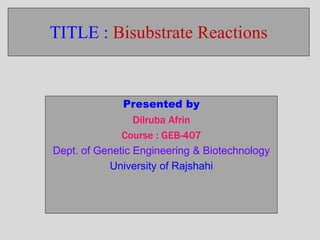Bisubstrate reactions enzyme kinetics
•Als PPTX, PDF herunterladen•
82 gefällt mir•65,760 views
Bisubstrate reactions,types and mechanisms with example (Enzyme kinetics)
Melden
Teilen
Melden
Teilen

Empfohlen
Empfohlen
Weitere ähnliche Inhalte
Was ist angesagt?
Was ist angesagt? (20)
Chemical modification of enzyme to improve physico-chemical properties

Chemical modification of enzyme to improve physico-chemical properties
Ähnlich wie Bisubstrate reactions enzyme kinetics
Ähnlich wie Bisubstrate reactions enzyme kinetics (20)
Kürzlich hochgeladen
Mehran University Newsletter is a Quarterly Publication from Public Relations OfficeMehran University Newsletter Vol-X, Issue-I, 2024

Mehran University Newsletter Vol-X, Issue-I, 2024Mehran University of Engineering & Technology, Jamshoro
Kürzlich hochgeladen (20)
ICT role in 21st century education and it's challenges.

ICT role in 21st century education and it's challenges.
This PowerPoint helps students to consider the concept of infinity.

This PowerPoint helps students to consider the concept of infinity.
Kodo Millet PPT made by Ghanshyam bairwa college of Agriculture kumher bhara...

Kodo Millet PPT made by Ghanshyam bairwa college of Agriculture kumher bhara...
HMCS Max Bernays Pre-Deployment Brief (May 2024).pptx

HMCS Max Bernays Pre-Deployment Brief (May 2024).pptx
Bisubstrate reactions enzyme kinetics
- 1. TITLE : Bisubstrate Reactions Presented by Dilruba Afrin Course : GEB-407 Dept. of Genetic Engineering & Biotechnology University of Rajshahi
- 2. Contents Bisubstrate Reactions sequential or single-displacement reactions Ordered sequential reactions Random sequential reactions ping-pong or double-displacement reactions
- 3. Bisubstrate Reactions When an enzyme catalyzing a reaction involving two substrates and yielding two products it is called Bisubstrate Reactions. Bi-substrate reactions account for ~ 60% of the known enzymatic reactions. 3
- 4. Bisubstrate Reactions Bisubstrate Reactions Sequential or single displacement Ping-pong or double displacement Ordered Random
- 5. 1.sequential or single-displacement reactions Sequential reactions are one of the classes involved in multiple substrate reactions. In these types of reactions ,all the substrates involved are bound to the enzyme before catalysis of the reaction takes place to release the products. In this reaction, a ternary complex of the enzyme and both substrates forms. There are two types of sequential reactions- Ordered sequential reactions Random sequential reactions
- 6. sequential or single-displacement reactions 1.Ordered sequential reactions Where a leading substrate binds first, followed by the other substrate The leading substrate A binds first, followed by B. Reaction between A and B occurs in the ternary complex and is usually followed by an ordered release of the products, P and Q.
- 7. sequential or single-displacement reactions This is another view of ordered sequential.
- 8. sequential or single-displacement reactions 2.Random sequential reactions Where either any of the substrate may bind first followed by the other substrate. In this type of sequential reaction, all possible binary enzyme-substrate and enzyme-product complexes are formed rapidly and reversibly when enzyme is added to a reaction mixture containing A, B, P, and Q (here A & B are the substrates ,P & Q are the products).
- 9. sequential or single-displacement reactions An example of a random sequential reaction A ternary complex is still observed for this random sequential reactions. Before catalysis, the complex includes the enzyme, ATP and creatine. After catalysis, the complex consists of the enzyme, ADP, and phosphocreatine. The overall direction of the reaction will be determined by the relative concentrations of ATP, ADP, Cr, and CrP and the equilibrium constant for the reaction.
- 10. Creatine Kinase Acts by a Random, Single- Displacement Mechanism Figure : The structures of creatine and creatine phosphate, guanidinium compounds that are important in muscle energy metabolism.
- 11. 2. ping-pong or double displacement reactions Group transfer reactions in which one or more products are released before all substrates bind the enzyme. The defining feature of double-displacement reactions is the existence of a substituted enzyme intermediate, in which the enzyme is temporarily modified. In this reaction, no ternary complex is formed.
- 12. ping-pong reactions Two stage reaction: 1.A functional group from 1st sub (A) is transferred to the 1st product (P) forming a stable enzyme (E') –The Ping 2.The functional group is displaced from the enzyme by the 2nd substrate (B) to yield 2nd product (Q), regenerating the original form of the enzyme (E) – The Pong
- 13. ping-pong or double displacement reactions An example of a ping-pong reaction Reactions that shuttle amino groups between amino acids and α-keto acids are classic examples of double-displacement mechanisms. The enzyme aspartate aminotransferase catalyzes the transfer of an amino group from aspartate to α- ketoglutarate.
- 14. ping-pong or double displacement reactions After aspartate binds to the enzyme, the enzyme removes aspartate's amino group to form the substituted enzyme intermediate. The first product, oxaloacetate, subsequently departs. The second substrate, α-ketoglutarate, binds to the enzyme, accepts the amino group from the modified enzyme, and is then released as the final product , glutamate.
- 15. THANKS TO ALL